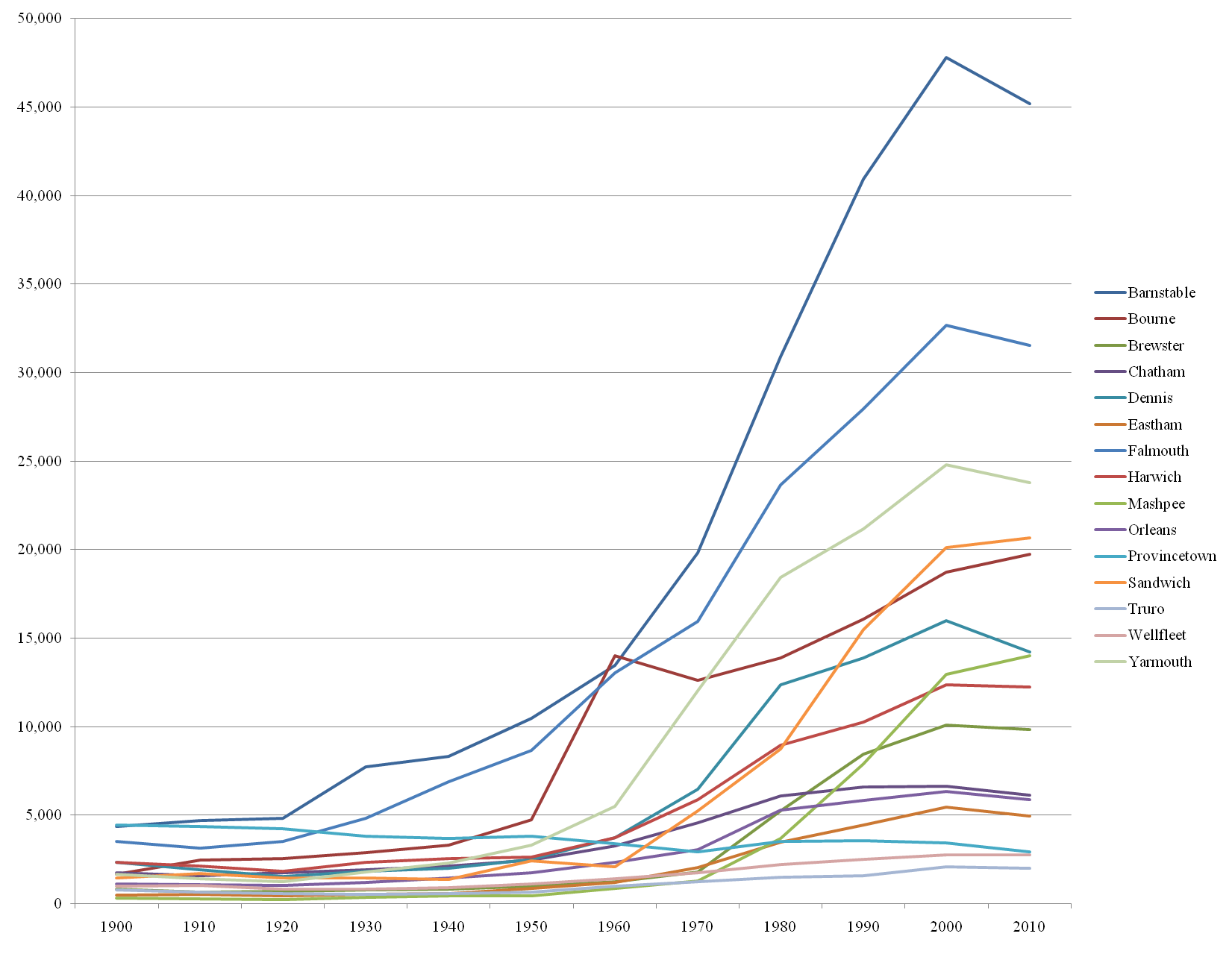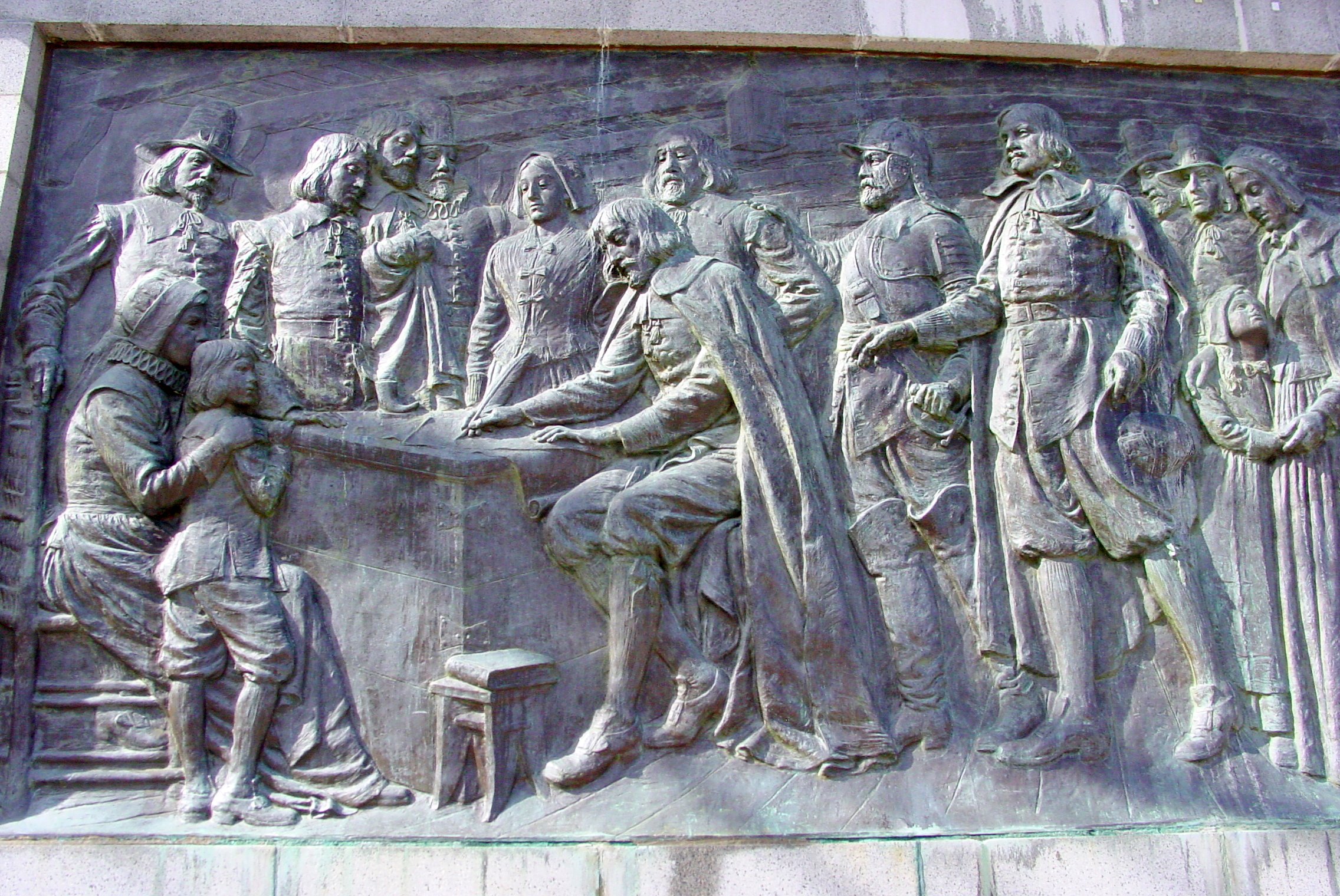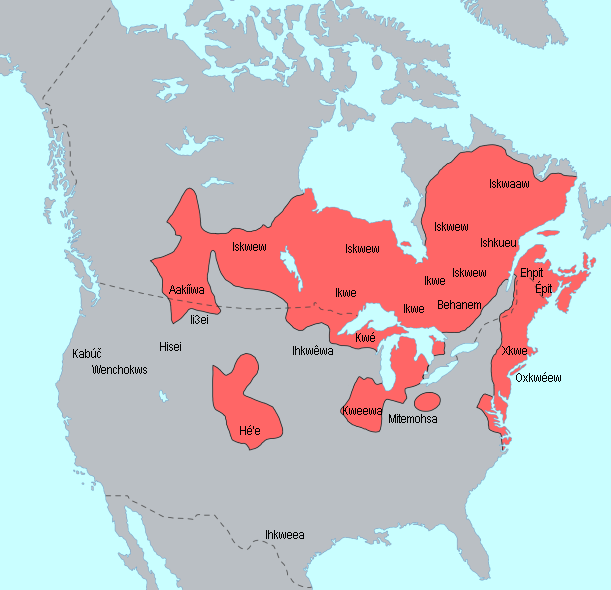|
Provincetown, Massachusetts
Provincetown () is a town located at the extreme tip of Cape Cod in Massachusetts. A small coastal resort town with a year-round population of 3,664 as of the 2020 United States census, Provincetown has a summer population as high as 60,000. It contains the census-designated place of the same name. Often called "P-town" or "Ptown", the locale is known as a vacation destination for its beaches, harbor, artists and tourist industry. History At the time of European encounter, the area was long settled by the historic Nauset tribe, who had a settlement known as "Meeshawn". They spoke Massachusett, a Southern New England Algonquian language dialect that they shared in common with their closely related neighbors, the Wampanoag. On May 15, 1602, having made landfall from the west and believing it to be an island, Bartholomew Gosnold initially named this area "Shoal Hope". Later that day, after catching a "great store of codfish", he chose instead to name this outermost tip of l ... [...More Info...] [...Related Items...] OR: [Wikipedia] [Google] [Baidu] |
Barnstable County, Massachusetts
Barnstable County is a County (United States), county in the U.S. state of Massachusetts. At the 2020 United States census, 2020 census, the population was 228,996. The county seat is Barnstable, Massachusetts, Barnstable. The county consists of Cape Cod and associated islands (some adjacent islands are in Dukes County, Massachusetts, Dukes County and Nantucket County). Barnstable County was formed as part of the Plymouth Colony on June 2, 1685, including the towns of Falmouth, Massachusetts, Falmouth, Sandwich, Massachusetts, Sandwich, and others to the east and north on Cape Cod. Plymouth Colony was merged into the Province of Massachusetts Bay in 1691. History Giovanni da Verrazzano Cape Cod is described in a letter from the Italian explorer Giovanni da Verrazzano to Francis I of France, relating the details of a voyage to the New World made on behalf of the French crown in the ship Dauphine, the only surviving of a fleet of four. Sailing from Madeira in 1524, the Dauphine ... [...More Info...] [...Related Items...] OR: [Wikipedia] [Google] [Baidu] |
Provincetown (CDP), Massachusetts
Provincetown (CDP) is a census-designated place (CDP) in the town of Provincetown in Barnstable County, Massachusetts, United States. The population was 2,642 at the 2010 census, out of 2,942 in the entire town. Geography The Provincetown CDP comprises the densely populated main settlement within the town of Provincetown. The CDP is bounded by U.S. Route 6 to the north, by the western extension of Massachusetts Route 6A (Province Lands Road) to the southwest, by Provincetown Harbor to the south, and by the Truro town line to the east. According to the United States Census Bureau, the CDP has a total area of , of which is land, and (65.86%) is water. Demographics As of the census of 2000, there were 3,192 people, 1,726 households, and 429 families residing in the CDP. The population density was 680.9/km (1,759.3/mi). There were 3,712 housing units at an average density of 791.8/km (2,045.9/mi). The racial makeup of the CDP was 87.53% White, 7.49% Black or African American ... [...More Info...] [...Related Items...] OR: [Wikipedia] [Google] [Baidu] |
Plymouth, Massachusetts
Plymouth ( ; historically also spelled as Plimouth and Plimoth) is a town in and the county seat of Plymouth County, Massachusetts, United States. Located in Greater Boston, the town holds a place of great prominence in American history, folklore, and culture, and is known as "America's Hometown". Plymouth was the site of the colony founded in 1620 by the ''Mayflower'' Pilgrims (Plymouth Colony), Pilgrims, where New England was first established. It is the oldest municipality in New England and one of the oldest in the United States. The town has served as the location of several prominent events, one of the more notable being the Thanksgiving (United States)#Harvest festival observed by the Pilgrims at Plymouth, First Thanksgiving feast. Plymouth served as the capital of Plymouth Colony from its founding in 1620 until the colony's merger with the Massachusetts Bay Colony in 1691. The English explorer John Smith (explorer), John Smith named the area Plymouth (after the city in Sou ... [...More Info...] [...Related Items...] OR: [Wikipedia] [Google] [Baidu] |
Signing Of The Mayflower Compact (Sculpture)
''Signing of the Mayflower Compact ''(1922) is a fifteen-figure, bas-relief sculpture by Cyrus E. Dallin located at the base of Monument Hill below the Pilgrim Monument in Provincetown, Massachusetts. The sculpture is one of three major commissions he received as part of the Pilgrim Tercentenary in 1920. The other two were the statue of Massasoit in Plymouth, Massachusetts and the Pilgrim half dollar, which featured renditions of a pilgrim and the ''Mayflower'' under sail. The relief sculpture is made of cast bronze and embedded in a substantial Rockport granite exedra with seating on either side. Dallin visited the site on May 6, 1922. The bronze plaque measures 9 by 16 feet and contains ten men, three women and two children gathered around a sea chest on which Governor William Bradford is signing the precedent making document. The setting is the beamed interior of a wooden ship lit by a lantern overhead. Governor Bradford is signing the document with a quill pen with Myle ... [...More Info...] [...Related Items...] OR: [Wikipedia] [Google] [Baidu] |
Mayflower Compact
The Mayflower Compact, originally titled Agreement Between the Settlers of New Plymouth, was the first governing document of Plymouth Colony. It was written by the men aboard the ''Mayflower,'' consisting of Separatist Puritans, adventurers, and tradesmen. Although the agreement contained a pledge of loyalty to the King, the Puritans and other Protestant Separatists were dissatisfied with the state of the Church of England, the limited extent of the English Reformation and reluctance of King James I of England to enforce further reform. The Mayflower Compact was signed aboard ship on , 1620. Signing the covenant were 41 of the ship's 101 passengers; the ''Mayflower'' was anchored in Provincetown Harbor within the hook at the northern tip of Cape Cod. History The Pilgrims had originally hoped to reach America in early October using two ships, but delays and complications meant they could use only one, the ''Mayflower''. Their intended destination had been the Colony of Vir ... [...More Info...] [...Related Items...] OR: [Wikipedia] [Google] [Baidu] |
Mayflower
''Mayflower'' was an English sailing ship that transported a group of English families, known today as the Pilgrims, from England to the New World in 1620. After 10 weeks at sea, ''Mayflower'', with 102 passengers and a crew of about 30, reached what is today the United States, dropping anchor near the tip of Cape Cod, Massachusetts, on , 1620. Differing from their contemporary Puritans (who sought to reform and purify the Church of England), the Pilgrims chose to separate themselves from the Church of England, which forced them to pray in private. They believed that its resistance to reform and Roman Catholic past left it beyond redemption. Starting in 1608, a group of English families left England for the Netherlands, where they could worship freely. By 1620, the community determined to cross the Atlantic for America, which they considered a "new Promised Land", where they would establish Plymouth Colony. The Pilgrims had originally hoped to reach America by early October ... [...More Info...] [...Related Items...] OR: [Wikipedia] [Google] [Baidu] |
Pilgrim (Plymouth Colony)
The Pilgrims, also known as the Pilgrim Fathers, were the English settlers who travelled to North America on the ship '' Mayflower'' and established the Plymouth Colony at what now is Plymouth, Massachusetts, United States. John Smith had named this territory New Plymouth in 1620, sharing the name of the Pilgrims' final departure port of Plymouth, Devon, England. The Pilgrims' leadership came from religious congregations of Brownists or Separatists who had fled religious persecution in England for the tolerance of 17th-century Holland in the Netherlands. These Separatists held many of the same Calvinist religious beliefs as Puritans, but unlike Puritans (who wanted a purified established church), Pilgrims believed that their congregations should separate from the Church of England, which led to their being labelled Separatists. After several years of living in exile in Holland, they determined to establish a new settlement in the New World and arranged with investors to fun ... [...More Info...] [...Related Items...] OR: [Wikipedia] [Google] [Baidu] |
Funk & Wagnalls
Funk & Wagnalls was an American publisher known for its reference works, including ''A Standard Dictionary of the English Language'' (1st ed. 1893–5), and the ''Funk & Wagnalls Standard Encyclopedia'' (25 volumes, 1st ed. 1912).Funk & Wagnalls New Encyclopedia, 1996 The encyclopedia was renamed ''Funk & Wagnalls New Standard Encyclopedia'' in 1931 and in 1945, it was known as ''New Funk & Wagnalls Encyclopedia'', ''Universal Standard Encyclopedia'', ''Funk & Wagnalls Standard Reference Encyclopedia'', and ''Funk & Wagnalls New Encyclopedia'' (29 volumes, 1st ed. 1971). The last printing of ''Funk & Wagnalls New Encyclopedia'' was in 1997. , annual Yearbooks are still in production. The I.K. Funk & Company, founded in 1875, was renamed Funk & Wagnalls Company after two years, and later became Funk & Wagnalls Inc., then Funk & Wagnalls Corporation. History Isaac Kaufmann Funk founded the business in 1875 as I.K. Funk & Company. In 1877, Adam Willis Wagnalls, one of Funk's cla ... [...More Info...] [...Related Items...] OR: [Wikipedia] [Google] [Baidu] |
Bartholomew Gosnold
Bartholomew Gosnold ( – ) was an English barrister, explorer and privateer who was instrumental in founding the Virginia Company in London and Jamestown in colonial America. He led the first recorded European expedition to Cape Cod. He is considered by Preservation Virginia (formerly known as the Association for the Preservation of Virginia Antiquities) to be the "prime mover of the colonization of Virginia". Early life and family Gosnold was born in Grundisburgh in Suffolk, England, in 1571, and his family seat was at Otley Hall, Otley, Suffolk. His parents were Anthony Gosnold of Grundisburgh and Dorothy Bacon of Hessett. Henry Gosnold, the judge and friend of Francis Bacon, was his cousin. Bartholomew had a younger brother Anthony, born sometime between 1573 and 1578, who accompanied him to Virginia as well as a cousin also named Anthony Gosnold who was still living in Virginia in 1615. In 1578, the will of Bartholomew's great-grandmother Ann Gosnold shows five sisters ... [...More Info...] [...Related Items...] OR: [Wikipedia] [Google] [Baidu] |
North-eastern View Of Provincetown, Mass (NYPL B13512827-420860)
The points of the compass are a set of horizontal, radially arrayed compass directions (or azimuths) used in navigation and cartography. A ''compass rose'' is primarily composed of four cardinal directions—north, east, south, and west—each separated by 90 degrees, and secondarily divided by four ordinal (intercardinal) directions—northeast, southeast, southwest, and northwest—each located halfway between two cardinal directions. Some disciplines such as meteorology and navigation further divide the compass with additional azimuths. Within European tradition, a fully defined compass has 32 "points" (and any finer subdivisions are described in fractions of points). Compass points or compass directions are valuable in that they allow a user to refer to a specific azimuth in a colloquial fashion, without having to compute or remember degrees. Designations The names of the compass point directions follow these rules: 8-wind compass rose * The four cardinal directio ... [...More Info...] [...Related Items...] OR: [Wikipedia] [Google] [Baidu] |
Wampanoag People
The Wampanoag, also rendered Wôpanâak, are a Native American people of the Northeastern Woodlands currently based in southeastern Massachusetts and formerly parts of eastern Rhode Island.Salwen, "Indians of Southern New England and Long Island," p. 171. Their historical territory includes the islands of Martha's Vineyard and Nantucket. Today, two Wampanoag tribes are federally recognized: * Mashpee Wampanoag Tribe * Wampanoag Tribe of Gay Head (Aquinnah). Herring Pond Tribe is a historical Wampanoag Tribe located in Plymouth and Bourne, Massachusetts The Wampanoag language, also known as Massachusett, is a Southern New England Algonquian language. Prior to English contact in the 17th century, the Wampanoag numbered as many as 40,000 people living across 67 villages composing the Wampanoag Nation. These villages covered the territory along the east coast as far as Wessagusset (today called Weymouth), all of what is now Cape Cod and the islands of Natocket and Noepe ( ... [...More Info...] [...Related Items...] OR: [Wikipedia] [Google] [Baidu] |
Algonquian Languages
The Algonquian languages ( ; also Algonkian) are a family of Indigenous languages of the Americas and most of the languages in the Algic language family are included in the group. The name of the Algonquian language family is distinguished from the orthographically similar Algonquin dialect of the Indigenous Ojibwe language (Chippewa), which is a senior member of the Algonquian language family. The term ''Algonquin'' has been suggested to derive from the Maliseet word (), meaning 'they are our relatives/allies'. Speakers of Algonquian languages stretch from the east coast of North America to the Rocky Mountains. The proto-language from which all of the languages of the family descend, Proto-Algonquian, was spoken around 2,500 to 3,000 years ago. There is no scholarly consensus about where this language was spoken. Family division This subfamily of around 30 languages is divided into three groups according to geography: Plains, Central, and Eastern Algonquian. Of t ... [...More Info...] [...Related Items...] OR: [Wikipedia] [Google] [Baidu] |









